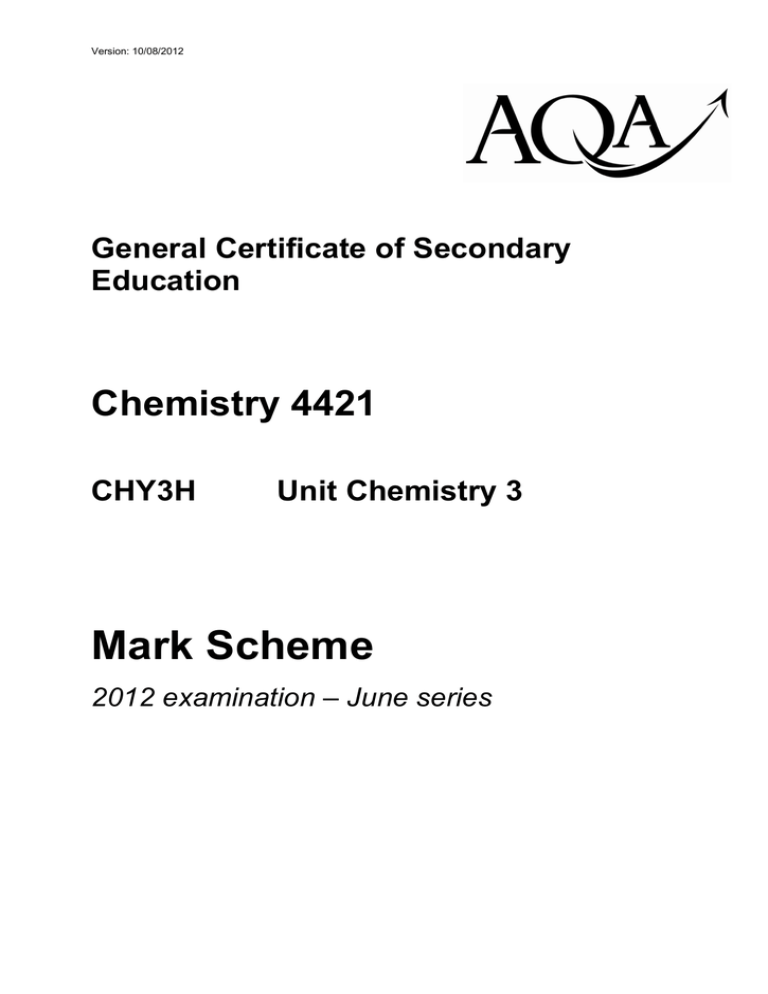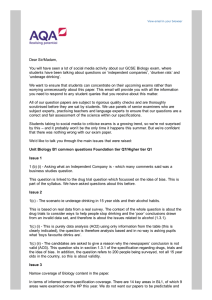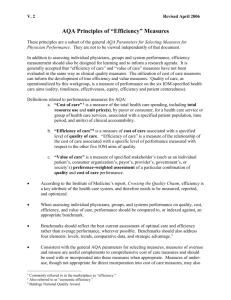
Version: 10/08/2012
General Certificate of Secondary
Education
Chemistry 4421
CHY3H
Unit Chemistry 3
Mark Scheme
2012 examination – June series
Mark schemes are prepared by the Principal Examiner and considered, together with the
relevant questions, by a panel of subject teachers. This mark scheme includes any
amendments made at the standardisation meeting attended by all examiners and is the scheme
which was used by them in this examination. The standardisation meeting ensures that the
mark scheme covers the students’ responses to questions and that every examiner
understands and applies it in the same correct way. As preparation for the standardisation
meeting each examiner analyses a number of students’ scripts: alternative answers not already
covered by the mark scheme are discussed at the meeting and legislated for. If, after this
meeting, examiners encounter unusual answers which have not been discussed at the meeting
they are required to refer these to the Principal Examiner.
It must be stressed that a mark scheme is a working document, in many cases further
developed and expanded on the basis of students’ reactions to a particular paper. Assumptions
about future mark schemes on the basis of one year’s document should be avoided; whilst the
guiding principles of assessment remain constant, details will change, depending on the content
of a particular examination paper.
Further copies of this Mark Scheme are available to download from the AQA Website: www.aqa.org.uk
Copyright © 2012 AQA and its licensors. All rights reserved.
COPYRIGHT
AQA retains the copyright on all its publications. However, registered schools / colleges for AQA are permitted to
copy material from this booklet for their own internal use, with the following important exception: AQA cannot give
permission to schools / colleges to photocopy any material that is acknowledged to a third party even for internal use
within the school / college.
Set and published by the Assessment and Qualifications Alliance.
The Assessment and Qualifications Alliance (AQA) is a company limited by guarantee registered in England and Wales (company number 3644723) and a registered charity (registered charity number 1073334).
Registered address: AQA, Devas Street, Manchester M15 6EX
Chemistry – AQA GCSE Mark Scheme 2012 June series
MARK SCHEME
Information to Examiners
1.
General
The mark scheme for each question shows:
•
•
•
•
the marks available for each part of the question
the total marks available for the question
the typical answer or answers which are expected
extra information to help the Examiner make his or her judgement and help to
delineate what is acceptable or not worthy of credit or, in discursive answers, to give
an overview of the area in which a mark or marks may be awarded.
The extra information is aligned to the appropriate answer in the left-hand part of the
mark scheme and should only be applied to that item in the mark scheme.
At the beginning of a part of a question a reminder may be given, for example:
where consequential marking needs to be considered in a calculation;
or the answer may be on the diagram or at a different place on the script.
In general the right hand side of the mark scheme is there to provide those extra details
which confuse the main part of the mark scheme yet may be helpful in ensuring that
marking is straightforward and consistent.
2.
3.
Emboldening
2.1
In a list of acceptable answers where more than one mark is available ‘any two
from’ is used, with the number of marks emboldened. Each of the following lines
is a potential mark.
2.2
A bold and is used to indicate that both parts of the answer are required to award
the mark.
2.3
Alternative answers acceptable for a mark are indicated by the use of or.
(Different terms in the mark scheme are shown by a / ; eg allow smooth / free
movement.)
Marking points
3.1
Marking of lists
This applies to questions requiring a set number of responses, but for which
students have provided extra responses. The general principle to be followed in
such a situation is that ‘right + wrong = wrong’.
Each error/contradiction negates each correct response. So, if the number of
error/contradictions equals or exceeds the number of marks available for the
question, no marks can be awarded.
However, responses considered to be neutral (indicated as * in example 1) are
not penalised.
3
Chemistry – AQA GCSE Mark Scheme 2012 June series
Example 1: What is the pH of an acidic solution? (1 mark)
Student
Response
1
2
3
4
4,8
green, 5
red*, 5
red*, 8
Marks
awarded
0
0
1
0
Example 2: Name two planets in the solar system. (2 marks)
Student
1
2
3.2
Response
Neptune, Mars, Moon
Neptune, Sun, Mars,
Moon
Marks awarded
1
0
Use of chemical symbols / formulae
If a student writes a chemical symbol / formula instead of a required chemical
name, full credit can be given if the symbol / formula is correct and if, in the
context of the question, such action is appropriate.
3.3
Marking procedure for calculations
Full marks can be given for a correct numerical answer, as shown in the column
‘answers’, without any working shown.
However if the answer is incorrect, mark(s) can be gained by correct
substitution / working and this is shown in the ‘extra information’ column;
3.4
Interpretation of ‘it’
Answers using the word ‘it’ should be given credit only if it is clear that the ‘it’
refers to the correct subject.
3.5
Errors carried forward
Any error in the answers to a structured question should be penalised once only.
Papers should be constructed in such a way that the number of times errors can
be carried forward are kept to a minimum. Allowances for errors carried forward
are most likely to be restricted to calculation questions and should be shown by
the abbreviation e.c.f. in the marking scheme.
3.6
Phonetic spelling
The phonetic spelling of correct scientific terminology should be credited unless
there is a possible confusion with another technical term.
3.7
Brackets
(…..) are used to indicate information which is not essential for the mark to be
awarded but is included to help the examiner identify the sense of the answer
required.
4
Chemistry – AQA GCSE Mark Scheme 2012 June series
CHY3H
Question 1
question
answers
extra information
mark
allow magnesium or calcium
throughout
1(a)
because the water contains
magnesium ions or magnesium
compounds / magnesium
sulphate
sodium carbonate / carbonate
ions reacts with the magnesium
ions / magnesium sulfate
to form solid / insoluble /
precipitate of magnesium
carbonate
allow because the water contains
magnesium / Mg2+ / Mg / Mg+ /
MgSO4
do not accept other ions
allow sodium ions exchange /
displace / magnesium ions
allow solid contains magnesium
(ions)
1
1
1
ignore scale / scum
1(b)(i)
any one from:
• anomalous
1
ignore error
• does not fit the pattern /
straight line
1(b)(ii)
water boils (at 100 °C)
1(b)(iii)
68 (°C)
1(b)(iv)
ignore evaporate
1
1
‘it’ = solubility
solubility goes up then down
(after 68 °C or ecf from 1(b)(iii))
allow solubility changes direction
allow solubility goes down /
decreases after 68°C (or ecf from
1(b)(iii))
1
1
solubility usually increases as the
temperature increases
Total
8
5
Chemistry – AQA GCSE Mark Scheme 2012 June series
CHY3H
Question 2
question
2(a)
answers
extra information
any two from:
mark
2
• react with water or very
reactive
• (react with water) releasing
gas / hydrogen / fizzing
• (react with water) to form an
alkaline / hydroxide solution
• form ions with a 1+ charge
allow lose one electron from the
outer shell
ignore other references to
electronic structure
ignore physical properties
2(b)
any three from:
3
• some boxes contain two
elements
allow specific examples:
• groups / columns contain
elements with different
properties
allow groups / columns contain
both metals and non-metals
• Newlands not a well-known /
respected scientist
ignore references to sugar
factory
• new idea (not readily accepted
by other scientists)
allow musical scales thought to
be silly by some scientists
Co, Ni or Ce, La or Di, Mo or
Ro, Ru or Ba, V or Pt, Ir
ignore examples
Question 2 continues on the next page . . .
6
Chemistry – AQA GCSE Mark Scheme 2012 June series
CHY3H
Question 2 cont’d…
question
2(c)
answers
extra information
one for improvement and one for
explanation from:
mark
2
• left gaps (for undiscovered
elements) (1)
• so that elements were in their
correct group (1)
allow so the elements fitted the
pattern of properties
or
• did not always follow order of
relative atomic weights /
masses (1)
ignore references to atomic
number / electronic structure
• so that elements were in their
correct group (1)
allow so the elements fitted the
pattern of properties
Total
7
7
Chemistry – AQA GCSE Mark Scheme 2012 June series
CHY3H
Question 3
question
3(a)
answers
extra information
any two from:
• do not react with water
• do not react with air
mark
2
allow unreactive or stay shiny or
do not tarnish or do not corrode
for either of first two points for 1
mark
ignore rusts
ignore durable
• malleable
ignore hard / strong
• high melting point
ignore boiling point
ignore other correct properties
3(b)
(transition elements have) same
number / two electrons in outer
shell / energy level / fourth shell
ignore references to (metallic)
structure / bonding
1
1
any one from:
• because lower energy level /
inner shell being filled
• because third energy level
can hold up to eighteen
electrons
Total
4
8
Chemistry – AQA GCSE Mark Scheme 2012 June series
CHY3H
Question 4
question
4(a)
answers
Hydrogen / H+
extra information
ignore state symbols
mark
1
ignore proton / H
4(b)
it = weak acid
pH of weak acid is higher than
the pH of a strong acid
allow converse for strong acids
allow correct numerical comparison
1
any one from:
allow converse for strong acids
1
• only partially dissociated
(to form ions)
allow ionises less
• not as many hydrogen
ions (in the solution)
allow fewer H+ released
4(c)(i)
(titration of) weak acid and
strong base
4(c)(ii)
0.61
1
correct answer with or without
working gains 2 marks
2
if the answer is incorrect:
moles of sodium hydroxide =
(30.5 x 0.5)/1000 = 0.01525 moles
or
(0.5 x 30.5/25) gains 1 mark
Question 4 continues on the next page . . .
9
Chemistry – AQA GCSE Mark Scheme 2012 June series
CHY3H
Question 4 cont’d..
question
4(d)
answers
12
extra information
correct answer with or without working
gains 2 marks or even with incorrect
working.
mark
2
if the answer is incorrect:
0.8 x 60 = 48g
or
evidence of dividing 48g (or ecf) by 4
or
0.8 x 250 = 0.8 = 0.8 x 0.25 = 0.2 mol
1000
4
or
evidence of multiplying 0.2mol (or ecf)
by 60
would gain 1 mark
Total
8
10
Chemistry – AQA GCSE Mark Scheme 2012 June series
Question 5
question
5(a)(i)
answers
(bubble gas produced through)
limewater
extra information
incorrect tests = zero
(limewater) goes cloudy / milky
5(a)(ii)
mark
1
1
ignore yes or no
red flame indicates that calcium
/ lithium ions present
allow aluminium has no flame
colour
1
or
Ca/Mg also produce a (white)
precipitate with NaOH
1
the (white) precipitate formed in
test 3 or by adding sodium
hydroxide solution would
dissolve (in excess) if
aluminium ions were present
5(a)(iii)
5(b)(i)
ignore yes or no
because a white precipitate is
formed in test 4 or by adding
silver nitrate
1
but chloride ions are in
hydrochloric acid
1
mass spectrometry
allow MS
1
or
atomic absorption spectroscopy
allow AAS
spectrometry / spectroscopy alone
is insufficient
5(b)(ii)
can detect a small(er) amount
of the substance
allow can detect small(er) changes
1
allow small(er) sample sizes
ignore references to precision /
accuracy
Total
8
11
Chemistry – AQA GCSE Mark Scheme 2012 June series
CHY3H
Question 6
question
6(a)
answers
extra information
all have seven electrons in their
outer shell / energy level
6(b)
chlorine atom is smaller than
bromine atom
or
chlorine atom has fewer shells
than bromine atom
mark
1
must be comparative in all points
or converse
1
1
outer shell / energy level of
chlorine has stronger
(electrostatic) attraction to the
nucleus than bromine
or
outer shell of chlorine is less
shielded from the nucleus than
bromine
so chlorine more readily gains an
extra electron
1
Total
4
12
Chemistry – AQA GCSE Mark Scheme 2012 June series
CHY3H
Question 7
question
7(a)(i)
answers
extra information
(-)810
ignore sign
mark
3
correct answer gains 3 marks
with or without working
if the answer is incorrect look at
the working up to a maximum of
two
• bonds broken = (4 x 414) +
(2x498) = 2652 kJ
• bonds formed = (2x803) +
(4x464) = 3462 kJ
• correct subtraction of their
bonds formed from their
bonds broken
7(a)(ii)
7(b)
because energy needed to break
the bonds
1
is less than the energy released
when bonds are formed
1
to provide activation energy
1
or
to break bonds
Total
6
UMS Conversion Calculator www.aqa.org.uk/umsconversion
13






